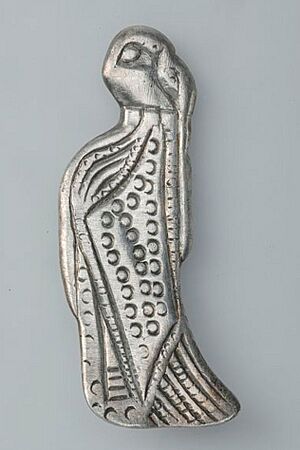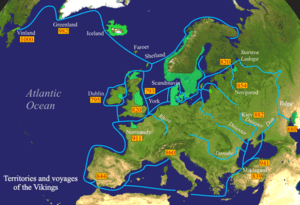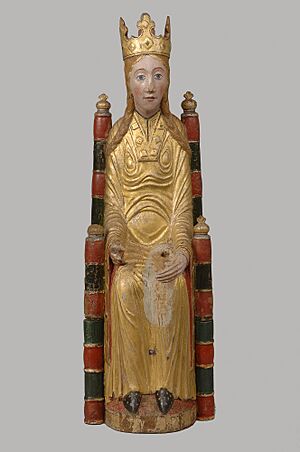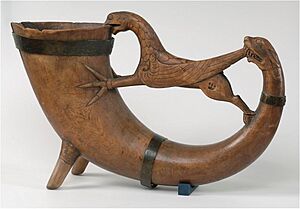Kingdom of Sweden (800–1521) facts for kids
Swedish pre-history ended around 800 AD. This is when the Viking Age began, and we started to have written records about what was happening. The Viking Age lasted until the mid-11th century. By 1100 AD, the Scandinavian countries had officially become Christian. The time from 1050 to 1350 is called the Older Middle Ages. This period ended when the terrible Black Death arrived in Europe. The Kalmar Union, which joined the Scandinavian countries, started in 1397. It lasted until King Gustav Vasa took power and ended it. The period from 1350 to 1523 is known as the Younger Middle Ages. King Gustav Vasa was crowned in 1523 after leading Sweden to become one united country in the Swedish War of Liberation. During these centuries, Sweden slowly became a single, strong nation.
Contents
The Viking Age: Explorers and Traders

Before the 9th century, people in Scandinavia lived in small kingdoms and areas ruled by chiefs. These were called petty kingdoms. We know about these kingdoms and their rulers mostly from old stories, a few writings from other countries, and runestones.
Around this time, the people of Scandinavia started to be seen as a group different from other Germanic nations. There was a big increase in war trips, known as Viking raids, to other countries. This is why we call this time the Viking Age. Back then, it was easier to travel by sea than through the thick forests inland in Europe. Wild areas that separated kingdoms were called marches.
Journeys to Faraway Lands

The Swedes joined the Danes and Norwegians in many raids on Western countries, especially England. They often successfully collected a payment called Danegeld to leave places alone. You can see this mentioned on some runestones in England.
Swedes were also very active traders and raiders in Eastern and Southeastern Europe. The large land of Russia, with its many rivers, was great for trading and finding treasures. These routes connected them with the Byzantine and Muslim empires. One result was the creation of the Varangian Guard, a special fighting group made up of Norsemen for the Byzantine emperor. Many experts believe that the Rus' people, who gave Russia its name, came from what is now eastern Sweden around the 8th century. Their name might come from Roslagen in Sweden.
During the 9th century, many Scandinavians settled on the eastern side of the Baltic Sea. An old story called Tale of Bygone Years (written in 1113) tells how the Varangians reached Constantinople. It also describes their pirate trips on the Black Sea and the Caspian Sea.
The Varangians became very rich from their trade with other countries. A major trading hub in Northern Europe grew on the island of Birka, not far from where Stockholm was later built. Birka became less important by 960, but discoveries from digs show it was very wealthy in the 9th and 10th centuries. Thousands of graves, coins, jewelry, and other fancy items have been found there.
Early Kings of Sweden
Old stories from Denmark, Norway, Iceland, and England tell us about Swedish kings from the Age of Migrations. These kings belonged to the Scylfing family, also known as Ynglings. Some stories say the Swedish kingdom started in the last centuries BC. Some of these old English writings, like Widsith and Beowulf, might be from the 8th century. They contain even older stories passed down by word of mouth. Scandinavian stories were first written down around the 9th century as poems. But they weren't put on paper until the 11th century or later.
In old myths, the first king of Sweden is said to have been Odin, who founded the Yngling family. You can find more about these legendary kings in the List of legendary kings of Sweden.
The earliest kings whose names appear in different stories (like Beowulf and Ynglingatal) are three kings from the 6th century. The first of these was Ongentheow or Egil. The first kings mentioned in a written source from their own time are in Rimbert's Vita Ansgarii, from the 9th century.
Before the 10th or 11th century, there were many different small kings ruling different parts of what would become Sweden. There was a lot of fighting between tribes, like the Geats and Swedes. Old stories sometimes disagree about who ruled when. These disagreements continue even after the time of Eric the Victorious, who ruled around 970–995. But we do know some things about him. Eric was followed by his son, King Olof Skötkonung (born in the late 960s, died around 1020). Olof was the first Christian king of Sweden. He was also the first king known to have ruled over the different tribes. Olof is usually listed as the first king in medieval Swedish lists, but modern ones often start with his father.
The Middle Ages: A New Era
How Christianity Came to Sweden
Before and during the early Viking Age, people in what is now Sweden mostly believed in Norse mythology. This was the main religion in most of southern Scandinavia. Swedes learned about Christianity during their early travels. We can see Christian influences on burials in some parts of Sweden as early as the late 8th century. Also, Irish missionary monks probably worked in some parts of Sweden. This is shown by Irish saints who were honored in the Middle Ages. Sweden is often thought to be the last of the Scandinavian countries (Sweden, Denmark, and Norway) to become Christian. They kept their old pagan beliefs the longest, with rulers like Blot-Sweyn.
From the Holy Roman Empire, a monk named Ansgar (801–865) started the first effort to bring Christianity to Sweden. Ansgar first visited Birka in 829. He was allowed to build a church and stayed as a missionary until 831. Then he went home and became Archbishop of Hamburg-Bremen. Around 850, he returned to Birka. He found that the Christian community he had started was gone. Ansgar tried to restart it, but it only lasted a few years. However, archaeological digs in Varnhem found a Christian burial ground from the late 9th century. In the same spot, a stone church was built in the early 11th century. A short distance away, Varnhem Abbey was built in the 12th century.

When Emund the Old became king around 1050, he had become Christian. But because he argued with Adalhard, the Archbishop of Bremen, the Church of Sweden did not become independent for another hundred years. Ten years later, in 1060, King Stenkil became king. By this time, Christianity was strong in most of Sweden, especially in Västergötland. However, the people of Uppland, with their main center in Uppsala, still followed their old pagan faith. Adalhard had managed to destroy the pagan idols in Västergötland. But he could not convince Stenkil to destroy the ancient Temple of Uppsala.
There are big gaps in what we know about the earliest Swedish rulers. However, the last king who followed the old Norse religion was Blot-Sweyn, who ruled from 1084–87. According to legend, Blot-Sweyn became king when his predecessor Inge refused to make sacrifices at Uppsala. His brother-in-law Sweyn stepped forward and agreed to make the sacrifice. This gave him the nickname Blot, which means sacrifice. Inge got his revenge three years later. He entered Uppsala with a large army, set Blot-Sweyn's house on fire, and killed him as he tried to escape.
It wasn't until Eric the Saint (1150–60) that the Church of Sweden was organized like other churches in the Middle Ages. A legend from the late 13th century says that Erik led the First Swedish Crusade to Finland. He went with the equally legendary Bishop Henry of Uppsala. They supposedly conquered the country and built many churches there. However, there are no historical records that prove this crusade happened.
After Christianity arrived, Uppsala became less important as a royal residence. But it became the home of the Swedish Archbishop in 1164. A large church, a cathedral, was built where the old Temple of Uppsala used to be. One of the first Swedish kings to be honored there was Eric the Saint.
Sweden Becomes One Nation
In the 11th and 12th centuries, old writings show that Sweden was mostly made up of self-governing provinces. We know that Olof Skötkonung was king of Svealand and at least parts of Götaland. But it's not clear if his kingdom included all of it. After Olof, the country was often divided between different rulers.
King Sverker I of Sweden (1134–55) is said to have permanently joined Götaland and Svealand.
The next centuries saw a rivalry between two powerful families: the House of Sverker in the Östergötland province and the House of Eric in the Västergötland province.
The 13th Century: Building a Nation
The most important medieval leader in Sweden was Birger Jarl. He was a regent, meaning he ruled for the king, from 1248 to 1266. He is seen as the founder of Stockholm and the person who created national laws. His changes helped end serfdom, a system where people were tied to the land.
The respect and power that later kings gained were further increased by Birger Jarl's son, King Magnus Ladulås (1275–90). Both these rulers tried to bring a feudal system, like in Europe, to Sweden. They did this by creating separate, almost independent areas ruled by dukes. This could have weakened the country by dividing it. But this danger was avoided, though there were violent conflicts with opponents like the Folkung party. (The term Folkung later also referred to Earl Birger's own family, who became the royal Folkunge of Bjelbo dynasty.) Finally, in 1319, the divided parts of Sweden were reunited.
Magnus Ladulås also helped create different social classes, or estates. He gave more rights to the clergy (church leaders) and basically started the formal Swedish nobility (see Ordinance of Alsnö, 1280). With this, a strong cavalry (soldiers on horseback) was formed, which was the core of the national army. Knights (the new nobles) and Burghers (townspeople) became distinct from the higher nobility. This time also saw the rise of an important class of townspeople, as towns began to get official rights. By the end of the 13th century and the start of the 14th, provincial laws appeared. The king and his council also made laws and handled legal matters.
Swedish-speaking culture had been spreading eastwards through Åland and along the coast of what is now Finland for centuries. But the Second Swedish Crusade, led by Birger Jarl in the late 1240s, is generally seen as the time when Finland became part of the Swedish state. This region remained a key part of Sweden until 1809. It was governed from the city of Åbo (Finnish: Turku).
Sweden and Norway Join Forces
The first time Sweden and Norway were united was in 1319. Magnus, who was only three years old, inherited the throne of Norway from his grandfather Haakon V. He was the son of the Swedish Duke Eric and the Norwegian princess Ingeborg. In the same year, he was chosen as King of Sweden at a meeting in Oslo.
Because the boy king was so young, his long childhood weakened the king's power in both countries. Magnus ended up losing both his kingdoms before he died. In Sweden, Magnus's favoritism and needs directly led to the rise of a powerful land-owning noble class. It also indirectly led to more freedom for ordinary people. Because the nobles were not very good at ruling, the king had to rely on the middle classes. In 1359, the king called the first Swedish Riksdag. For the first time, representatives from the towns were invited to join the nobles and clergy. The Swedes were annoyed by Magnus's poor rule. They replaced him with his nephew, Albert of Mecklenburg, in 1365. Albert was forced to take his first coronation oath in 1371. In this oath, Albert promised to give many of his powers to the nobles in the Regency Council.
The Kalmar Union
In 1388, the Swedes asked Margaret I of Denmark for help. Albert was driven out. At a meeting of representatives from the three Scandinavian kingdoms (held at Kalmar in 1397), Margaret's great-nephew, Eric of Pomerania, was chosen as the common king. However, the rights and freedoms of each of the three kingdoms were clearly protected and confirmed. The union was meant to be a personal union, meaning they shared a king, but not a political one, meaning each country kept its own laws.
Neither Margaret nor the kings who came after her followed the rule that only people born in each kingdom should hold land and high positions. Denmark, which was by far the strongest member of the union at the time, tried to force its will on the weaker kingdoms. This soon led to countries leaving the union.
The Swedes first broke away from the Union in 1434 under a popular leader named Engelbrekt Engelbrektsson. After he was murdered, they chose Karl Knutsson Bonde as their king, with the title of Charles VIII, in 1436. In 1441, Charles VIII had to step down in favor of Christopher of Bavaria, who was already king of Denmark and Norway. However, when Christopher died in 1448, a period of confusion followed. During this time, Charles VIII was made king twice more and then expelled twice again. Finally, after Charles VIII died in 1470, the three kingdoms were reunited under Christian II of Denmark. The church leaders and higher nobles of Sweden supported this union.
See also
- Provinces of Sweden
- History of Scandinavia
- List of runestones
- Swedish History Museum
- Garðar Svavarsson



